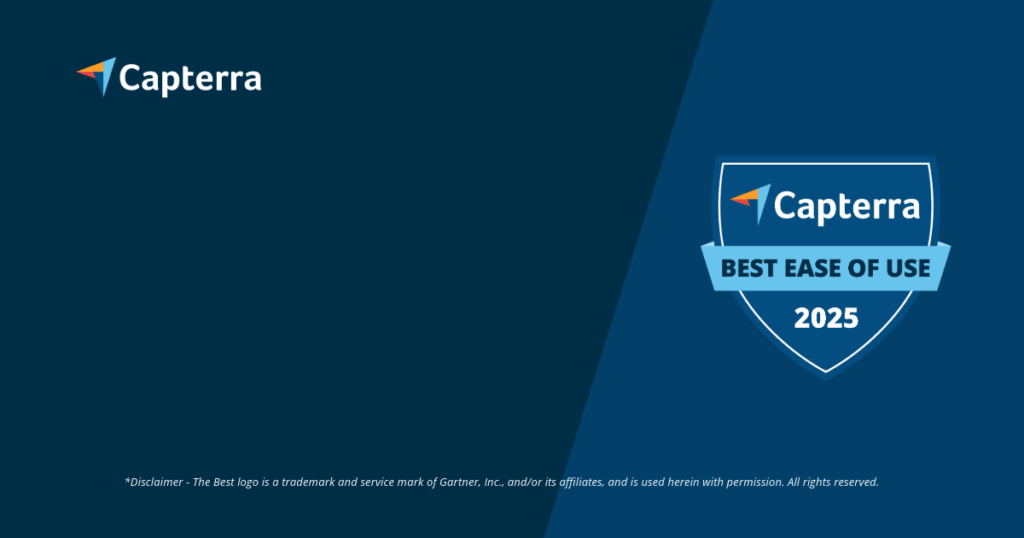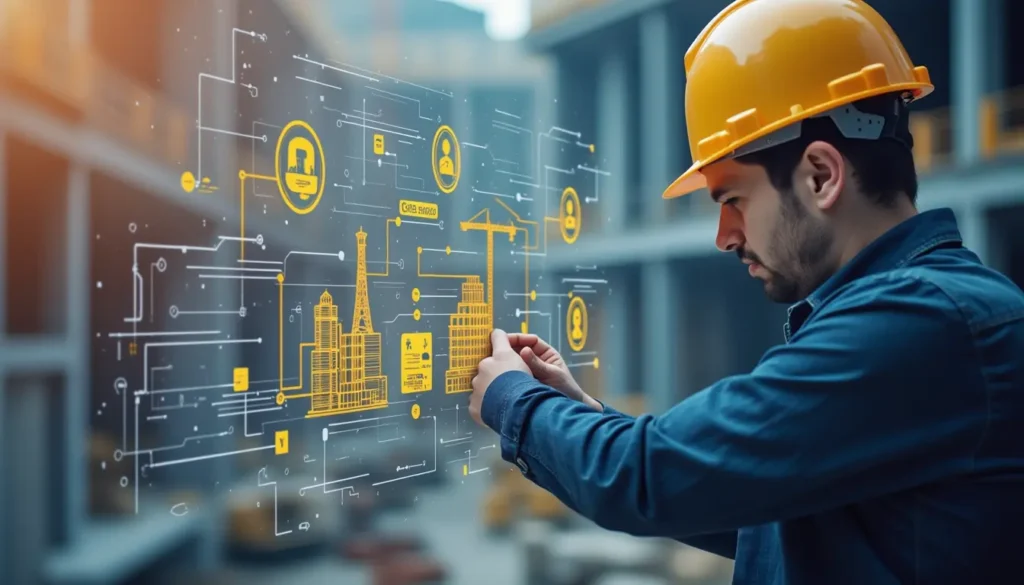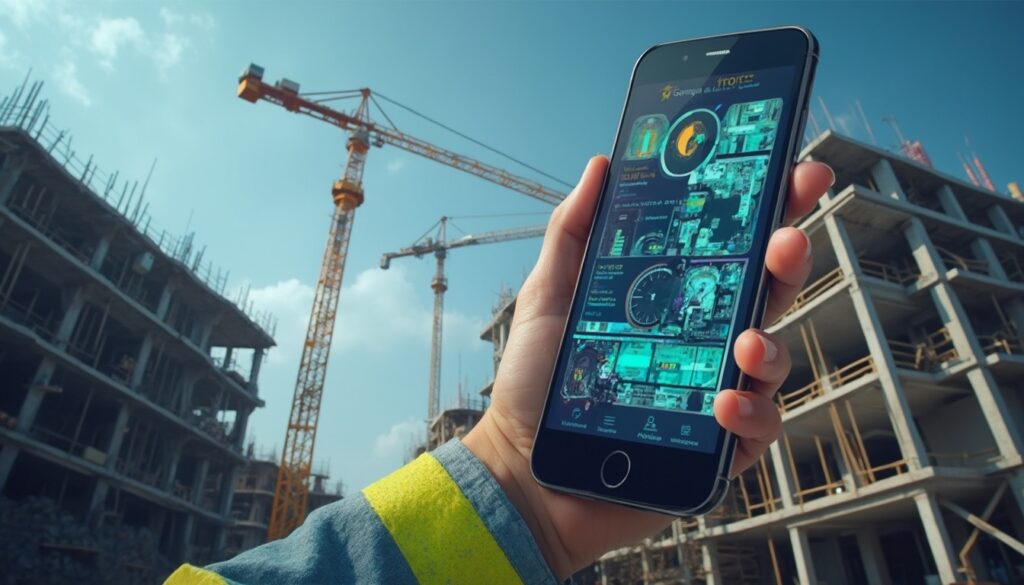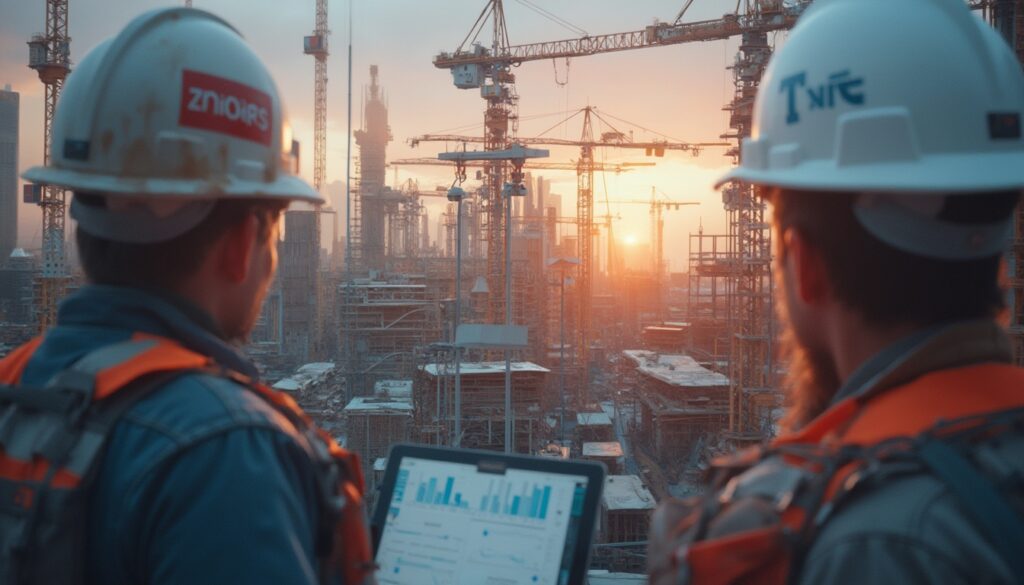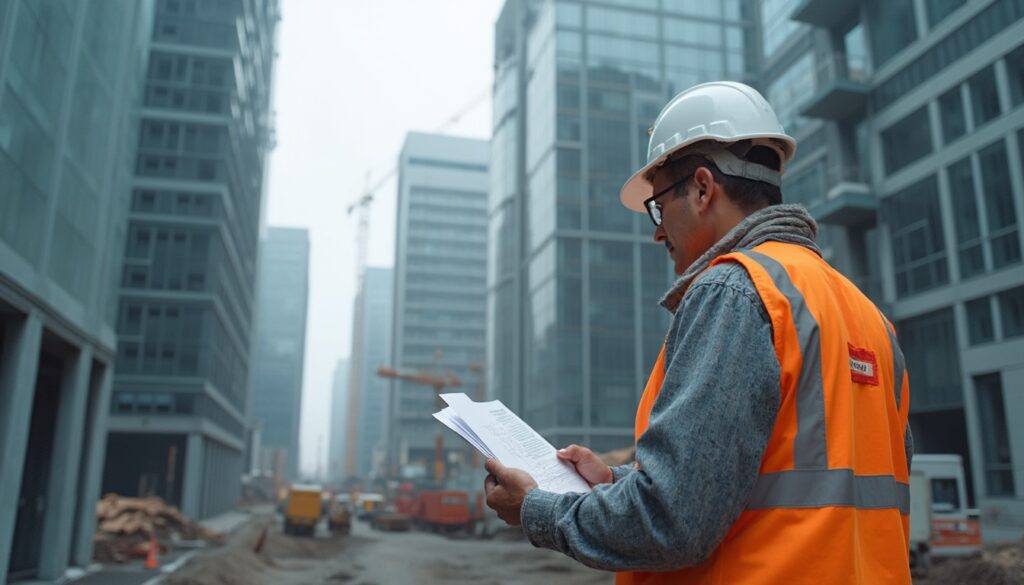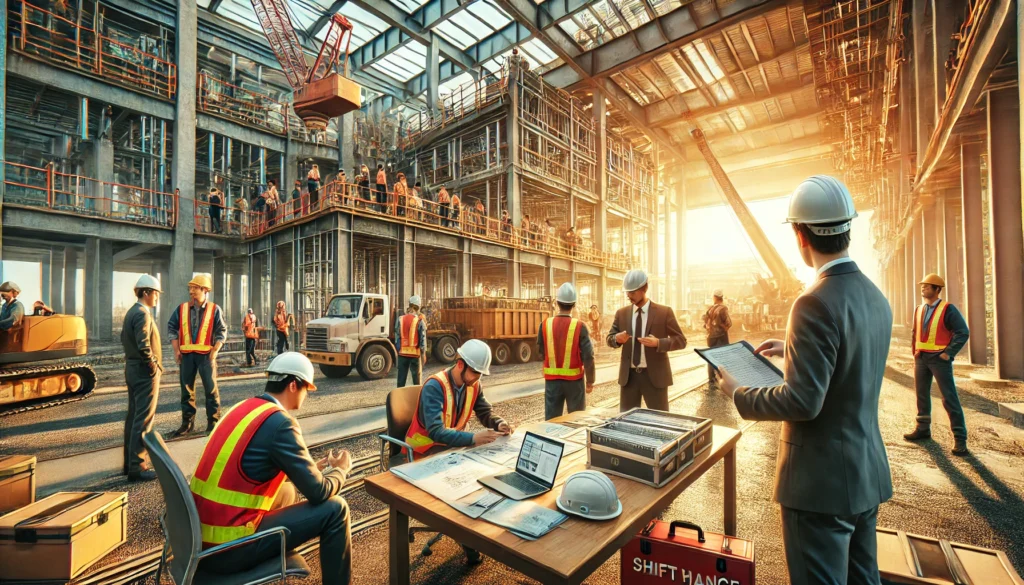Risk minimization in the construction industry: This is how you lay the foundation for your project success
The construction industry is a sector full of dynamics and opportunities, but let’s be honest, it also poses a number of challenges. Proactive management of the risks in the construction industry is not just a precautionary measure, but a fundamental building block for the success of every single construction project. Given rising costs, increasingly complex projects, and a market environment that is constantly changing, it is essential for all of us in the industry to identify potential hazards early and take effective countermeasures. This is where we, Valoon GmbH, come into play: We want to support you in mastering these challenges. We understand from our own experience that optimized communication and data processing are crucial to address the various risks in the construction industry risks and ensure projects reach their goals safely. Discover with us how the use of innovative software solutions can not only minimize risks but also sustainably increase the efficiency and transparency of your construction projects. Please feel free to contact us for individual advice – we will show you how we can secure your projects.
- Proactive risk management is fundamental to project success in the construction industry.
- Valoon GmbH supports tackling these challenges through optimized communication and data processing.
- The risk landscape in construction is multi-faceted and includes financial, technical, personnel, legal, and criminal aspects.
- A proactive risk assessment allows for early identification of hazards and the implementation of preventive measures.
The complexity of the risk landscape in the construction industry
Die risks in the construction industry is incredibly diverse and goes far beyond obvious issues like construction delays. Just think of financial uncertainties, technical challenges, personnel shortages, and legal pitfalls. For example, unexpected price increases in building materials or the sudden insolvency of a key subcontractor can place a heavy financial burden on a project. Technical risks often manifest as planning errors or execution defects, which then lead to costly rework. And the shortage of skilled labor – a topic familiar to us all – further exacerbates the situation and can seriously jeopardize compliance with quality standards and timelines. Additionally, often underestimated criminal risks such as undeclared work or fraud can cause not only financial but also significant reputational damage. A comprehensive understanding of this complex risk landscape is truly the first step to gaining control over it.
Why proactive risk assessment is crucial
A reactive approach to risk management, where one only acts after problems arise, often leads to higher costs, significant time losses, and quality deficits. In stark contrast, a risks in the construction industryproactive risk assessment allows for early identification of potential sources of danger. This gives you the necessary leeway to develop and implement preventive measures. According to a report, factors such as high construction prices and slow approval processes heavily burden companies. Through systematic analysis, such external factors can be better anticipated and their impacts mitigated. Proactive management of the potenzieller Gefahrenquellen. Das verschafft Ihnen den notwendigen Handlungsspielraum, um präventive Maßnahmen zu entwickeln und zu implementieren. Laut einer belasten Faktoren wie hohe Baupreise und schleppende Baugenehmigungen die Unternehmen stark. Durch eine systematische Analyse können solche externen Faktoren besser antizipiert und deren Auswirkungen abgefedert werden. Ein proaktives Management der risks in the construction industry not only protects the individual project but also strengthens the competitiveness and reputation of your entire company. It is about reducing uncertainties and creating a solid foundation for sustainable success.
Valoon GmbH: Your partner for efficient risk management through optimized communication and data processing
At Valoon GmbH, we have made it our mission to optimize communication and project management in the construction industry. Our cloud-based SaaS platform is specifically designed to effectively address the specific risks in the construction industry challenges of the industry. How? By simplifying data collection and processing and sustainably improving the flow of information between field and office. A core problem of many construction projects is the often unstructured communication that can quickly lead to misunderstandings and mistakes. Our solution enables the seamless integration of common messaging services such as WhatsApp. This means your field employees can use familiar tools while the information is automatically structured and converted into usable project data in the background. This not only reduces training efforts but also eliminates information overload and lowers barriers to digitization. With features such as centralized task management, intelligent reporting, and automatic translation, we actively support you in minimizing the various risks in the construction industry and making your projects more efficient.The many faces of construction risks: Mastering financial, temporal, and technical hurdles
The spectrum of risks in the construction industry construction risks is truly wide-ranging and can affect projects in a multitude of ways. A precise understanding of these various risk categories is absolutely critical if one wants to manage them effectively. From unforeseen cost explosions to critical delays and technical defects – every single phase of a construction project can be threatened by specific hazards. If we can identify and assess these potential problems early, we can develop targeted risk mitigation strategies and thus safeguard project objectives regarding quality, timelines, and costs. Because the impacts of these risks can be severe, ranging from financial losses to tangible reputational damage.
- Financial risks: Be mindful of budget overruns, fluctuating material costs, and potential insolvencies of partners.
- Temporal risks: Account for delays due to approval processes, unpredictable weather, and planning errors.
- Technical risks: Minimize dangers from deficient execution, construction errors, and inadequate quality control.
- Personnel risks: Address the shortage of skilled labor, qualification gaps, and safety deficits on construction sites.
- Environmental and criminal risks: Do not underestimate the impacts of environmental violations or criminal activities such as fraud.
Financial risks: keeping an eye on budget overruns, fluctuating material costs, and insolvencies
Financial risks risks in the construction industry are likely among the greatest threats to construction projects. Budget overruns are unfortunately a common phenomenon, often caused by inaccurate cost estimates or unforeseen events. The volatility of material costs, driven by global supply chain issues and raw material shortages, is making reliable calculations increasingly difficult. Another critical point is the insolvency risk of subcontractors; the failure of a key partner can lead to significant delays and additional costs – a nightmare for any project manager. In international projects, currency risks also come into play, which can diminish profitability. Therefore, solid financial management that accounts for contingencies and carefully checks the solvency of partners is essential in mitigating these specific risks. The industry also plays an important role in this, let’s not forget.
Temporal risks: When approvals, weather, and planning errors derail the timeline
Temporal risks risks in the construction industry can significantly disrupt the entire project flow. Lengthy approval processes and bureaucratic hurdles are often hard to predict and frequently lead to delayed construction starts. And then there’s the weather: Unpredictable weather conditions, such as extreme heat waves, storms, or heavy rainfall, can render work impossible and completely disrupt the timeline. But internal factors such as planning errors, insufficient preparation, or lack of coordination between trades are also common causes of delays. These temporal shifts not only incur additional costs, such as longer equipment rentals or penalty fees, but can also negatively impact team motivation and undermine client trust. Careful planning that also accounts for buffer times and a flexible response to unforeseen events are crucial to manage these risks. A thoughtful management of construction time extensions is really essential here.
Technical risks: From deficient execution to inadequate quality control
Technical risks risks in the construction industry threaten the quality and safety of our structures. Defective execution by unqualified personnel or the use of substandard materials can lead to serious construction defects, the remediation of which is often complex and very costly. Construction errors that may occur during the planning phase, can compromise the stability and functionality of the entire structure. And inadequate quality control during the construction phases means that errors are often detected far too late, which naturally drives up the costs of correction. The consequences range from rework to usage restrictions to genuine safety risks for later users. To minimize these risks, careful planning, selecting qualified partners, and thorough documentation alongside the review of all work steps are absolutely essential. An effective defect management is of great importance here.
Personnel risks: Shortage of skilled labor, qualification gaps, and safety deficits
The human factor also poses significant risks in the construction industryrisks. The omnipresent shortage of skilled labor means that often not enough qualified personnel are available, which can negatively affect execution quality and adherence to timelines. Lack of training and experience among employees increases the risk of errors and unfortunately also of work accidents. Safety deficiencies on construction sites, caused by inadequate protective measures, lack of training, or disregarding regulations, can lead to serious injuries or even fatalities. This has not only tragic human consequences but also brings legal and financial repercussions for the company. Investments in employee training and consistent implementation of safety standards are therefore crucial to reduce these personnel risks.
Environmental risks: When the construction site becomes a danger to nature
Environmental risks are becoming increasingly important in the context of risks in the construction industry construction. Improper disposal of construction waste or hazardous materials can lead to significant environmental pollution and incur high fines and remediation costs. The failure to comply with environmental regulations and laws, whether in the area of noise protection, water conservation, or soil protection, can not only have legal consequences but also harm the company’s image sustainably. Construction projects often interfere with existing ecosystems, which is why careful planning and implementation of environmental protection measures are essential. This includes the correct handling and disposal of materials as well as minimizing emissions and observing conservation areas. A responsible approach to the environment is not only a legal obligation but also an important contribution to sustainability and acceptance of construction projects and helps avoid specific risks.
Criminal risks: Don’t underestimate black work, fraud, and corruption
Criminal acts often represent underestimated but very serious risks in the construction industry risks. Unreported work and tax evasion, often favored by price pressure and a shortage of skilled workers, can lead to severe penalties and back payments. Fraud cases, such as manipulated billing or the failure to deliver agreed services not only harm financially but also destroy trust between contracting parties. Corruption, such as offering advantages to expedite approval processes, is also a serious problem that can have criminal consequences and lead to exclusion from public contracts. Preventing such offenses requires transparent processes, clear compliance guidelines, and a corporate culture that promotes integrity and uprightness. Combatting this type of risk is critical for the reputation and long-term success of any company in our industry.What studies say: Construction prices and approvals as top risk factors in focus
When we look at current studies and expert opinions, we gain valuable insights into the most pressing risks in the construction industryrisks. These insights are invaluable as they help all of us sharpen our risk management strategies and focus on the factors that truly matter. Identifying risk priorities is as important as understanding the diverse impacts that these risks can have on our projects. A systematic approach to risk analysis offers significant advantages that go far beyond mere damage avoidance and contributes to overall project optimization. It is clear: These risks are dynamic and require continuous monitoring and adjustment of our countermeasures.
PwC Study 2025: High construction prices, slow approvals, and world politics put pressure on construction companies
The study paints a very clear picture of the current burdens on construction companies. Almost half of the surveyed companies (46 percent!) state that the current framework conditions significantly or even very significantly affect their business activities. The main drivers of this development are the persistently high construction price levels (who doesn’t know this?), sluggish building approvals, and geopolitical uncertainties that lead to resource shortages. These factors significantly increase financial and temporal risks in the construction industry challenges. The study emphasizes how important it is for companies to strengthen their resilience to external shocks and develop flexible planning and procurement strategies. Only in this way can we successfully manage the diverse risks and remain competitive.
ConstructConnect: A look at financial, contractual, operational, and environmental construction risks
According to the study, construction risks can be categorized into various categories: financial, contractual, operational, and environmental risks. These can have both internal and external causes – an important distinction! The most common risks include safety risks that lead to work accidents (a perennial issue) and the often complex management of change orders. This categorization helps us structure the complexity of risks in the construction industry construction risks better and develop targeted management approaches. Contractual risks often arise from unclear wording or unfair clauses – here caution is advised! Operational risks include inefficient processes or machinery failures. And environmental risks, such as unforeseen soil contamination, can also have significant impacts. A comprehensive understanding of these categories is critical for identifying and properly assessing specific risks in each individual project.
Built-Smart-Hub: Why risk analysis is so important in construction
The importance of risk analysis in construction is indisputable, and we can only agree with that. Numerous risks can arise, broadly categorized into financial and temporal risks. Financial risks include budget overruns, unforeseen costs, and funding gaps. Temporal risks involve delays due to weather conditions, material deliveries, or government approvals – the classics. The article emphasizes that the early detection and assessment of these risks is absolutely crucial for initiating appropriate countermeasures. A thorough risk analysis helps not only predict potential problems but also better assess the likelihood of their occurrence and their possible impacts. This is an important step to proactively tackle the various risks in the construction industry challenges and ensure our project goals. Addressing construction delays according to VOB is an important aspect that should not be neglected.
JetBlackSafety: The top 10 health and safety risks on the construction site
Safety on construction sites – a central theme when it comes to risks in the construction industry health and safety, and one that should matter to us all. Falls from heights are identified as the number one safety risk. And indeed: Falls from heights are the leading cause of fatal injuries at work, according to statistics from the Health and Safety Executive (HSE). This finding underscores the immense importance of preventive measures such as scaffold safety, personal protective equipment, and comprehensive safety training. In addition to falls, risks from falling objects, noise pollution, or handling hazardous materials are also common sources of danger. The prioritization of health and safety aspects is not only a legal obligation but also an ethical requirement. It contributes significantly to preventing human suffering and minimizing the negative impact of workplace accidents on projects and the company’s reputation. Addressing these specific risks is simply essential.
Recognizing risk priorities and understanding their impacts
The effective handling of risk management risks in the construction industry starts with correctly identifying and prioritizing them. Not all risks have the same likelihood of occurrence or the same damage potential. Studies show that planning errors and delays not only occur frequently, but also have the greatest impact on project quality, timelines, and financial results. This suggests that we need to place a stronger focus on the upstream planning processes and precise resource allocation. Risk assessment should therefore always consider their potential effects on the project’s core objectives. Clear prioritization allows us to allocate resources where they provide the greatest benefit and effectively address the most serious risks. Involving all stakeholders in this process is crucial to ensure a truly comprehensive risk assessment.
The unbeatable advantages of systematic risk analyses
A systematic risk analysis offers much more than just identifying potential problems in the context of risks in the construction industryconstruction. It demonstrably supports the assessment of project feasibility, minimizing losses, and quantifying costs. Furthermore, it helps determine profitability, manage insurance premiums, secure warranties, and protect reputation – quite a lot! Thus, proactive risk management creates a holistic value for the construction project and the executing company. By systematically capturing and assessing risks, informed decisions can be made, and uncertainties reduced. This leads to improved planning and control, which in turn increases the likelihood of successfully completing projects within the established objectives. The implementation of such analyses is a sign of professional conduct and an important step toward mastering the diverse risks.Effective risk management: This is how to implement strategies for safe construction projects
A structured approach to risk management is simply essential for gaining control over the complex risks in the construction industry issues. It’s not just about reacting to problems that have already occurred, but about planning ahead and recognizing and mitigating potential dangers early on. Successful risk management in our construction industry relies on proven processes and, crucially, the close collaboration of all stakeholders. By implementing clearly defined strategies, we can reduce uncertainties and achieve our project goals despite the various risks. This naturally requires continuous adjustments and a dynamic understanding of the ever-changing risk landscape.
- Implement a four-step process: Identify, assess, mitigate, and continuously monitor risks.
- Define your risk appetite and tolerance, to weigh between proactive and reactive strategies.
- Foster the collaboration of all stakeholders and establish clear, open communication.
- Maintain a dynamic risk register for comprehensive documentation and tracking of risks.
- Utilize historical project data and learning loops for the continuous improvement of your risk management strategies.
The four-step process: Identify, assess, mitigate, and monitor risks
A well-established approach to risk management is the four-step process. It provides us with a structured method to handle the risks in the construction industry risks. The first step is risk identification: Here we systematically capture all potential sources of danger that could affect our project. This can be done through brainstorming in the team, checklists, expert interviews, or analyzing historical data. In the second step, risk assessment, we analyze and prioritize the identified risks – how likely is their occurrence, and how great would the potential damage be? This is followed by risk mitigation (sometimes also referred to as risk management). Here we develop concrete measures and plans to reduce the likelihood or impact of the most critical risks. These can be preventive measures or reactive protocols in case something does happen. The fourth and final step is continuous risk monitoring, where we consistently observe the risk landscape and the effectiveness of our measures and adjust them as needed. This iterative, recurring process is vital for keeping dynamic risks under control.: Hier erfassen wir systematisch alle potenziellen Gefahrenquellen, die unser Projekt beeinträchtigen könnten. Das kann durch Brainstorming im Team, Checklisten, Expertenbefragungen oder die Analyse historischer Daten geschehen. Im zweiten Schritt, der Risikobewertung, analysieren und priorisieren wir die identifizierten Risiken – wie wahrscheinlich ist ihr Eintreten und wie groß wäre der potenzielle Schaden? Darauf folgt die Risikominderung (manchmal auch Risikobewältigung genannt). Hier entwickeln wir konkrete Maßnahmen und Pläne, um die Wahrscheinlichkeit oder den Einfluss der wichtigsten Risiken zu reduzieren. Das können präventive Maßnahmen sein oder auch reaktive Protokolle für den Fall, dass doch etwas passiert. Der vierte und letzte Schritt ist die kontinuierliche Risikoüberwachung. Dabei beobachten wir laufend die Risikolandschaft und die Wirksamkeit unserer Maßnahmen und passen sie bei Bedarf an. Dieser iterative, sich wiederholende Prozess ist entscheidend, um die dynamischen Risiken im Griff zu behalten.
Proactive or reactive? Accurately assess risk appetite and risk tolerance
In managing the risks in the construction industry risks, we as a company face the choice between proactive and reactive strategies. A proactive approach aims to avoid risks from the outset or minimize their impacts through preventive measures before they even occur. In contrast, reactive strategies come into play only when a risk has already materialized, focusing on damage limitation and corrective measures. The decision for a particular strategy largely depends on the risk appetite and the risk tolerance of our company. Risk appetite defines how much risk a company is willing to take on to achieve its goals, while risk tolerance sets the acceptable deviations from those goals. A clear understanding of these parameters helps us focus our efforts in dealing with risks and allocate our resources efficiently.
Collaboration is key: Stakeholder cooperation and clear communication
Successful identification and management of the risks in the construction industry risks depend critically on the cooperation of all involved stakeholders. This includes architects, builders, general contractors, subcontractors, and suppliers – essentially everyone involved in the project. Each actor brings a specific perspective and valuable insights into potential risks within their areas of responsibility. Open and transparent communication is essential to gather all this information and form a comprehensive picture of the project-specific risks that goes far beyond generic risks such as weather conditions. Regular meetings, clear reporting lines, and the use of collaborative platforms can greatly enhance information exchange and ensure that all parties are informed about current risk assessments and mitigation measures. This collaborative approach is a real key to effectively managing the diverse risks. A good risk management strategy always takes this into account.
Everything documented: Dynamic risk registers for complete oversight
Careful documentation is an absolutely central part of the risk management process when we deal with risks in the construction industry . Maintaining a dynamic risk register is particularly valuable in this context. Imagine this: such a register lists all identified risks, their assessment (i.e., likelihood of occurrence and impact), the planned and already implemented countermeasures, as well as the responsible persons (the so-called Risk Owners). Dynamic means that this register is continuously updated, as soon as new information becomes available or conditions change. Integrating the risk register into project management software enables real-time updates, automated risk tracking, and improved communication among stakeholders. This ensures that risk management is not a static process, but adapts to the constantly changing conditions of a construction project, helping us to effectively control risks.
Learning from the past: Utilizing historical data and learning loops
Analyzing historical data from completed projects is an incredibly valuable source to identify and assess risks in the construction industry risks better. As construction companies, we should maintain comprehensive databases that include risk logs, information on cost overruns, scheduling delays, and the countermeasures taken in past projects. By evaluating this data, we can recognize patterns and trends that allow us to make more accurate risk predictions and develop more effective mitigation strategies for future projects. Implementing learning loops, for example through structured post-project reviews that specifically focus on the effectiveness of risk management, is crucial here. These reviews help us to learn from successes and failures and continuously improve our risk management process. This ensures that our company continuously develops its ability to deal with complex risks in the construction industry challenges.
BIM as a helper: Minimizing risk through Building Information Modeling
Building Information Modeling, or BIM, is becoming an increasingly important tool in our fight against risks in the construction industry. BIM allows us to create a detailed digital model of the building that includes not only geometric information but also data on materials, costs, and schedules. By visualizing and simulating various construction phases, we can identify and address potential issues such as design collisions, tricky constructability questions, or material waste early on—before they lead to costly delays on the construction site. BIM greatly promotes cooperation among different planning disciplines and enhances communication, which in turn reduces the risk of misunderstandings and errors. Integrating risk analysis workflows with BIM can increase the accuracy of risk assessments and help us proactively manage the diverse risks in the construction industry, particularly in the technical field. Engaging with challenges in construction is definitely facilitated by BIM.Valoon takes action: Digital tools for your effective risk prevention in construction
In an industry characterized by complexity and unpredictability, technology plays an increasingly crucial role in minimizing our risks in the construction industry risks. At Valoon GmbH, we pride ourselves on offering innovative software solutions specifically designed to support construction companies like yours in tackling these challenges. Our approach is clear: we want to simplify processes, improve communication, and intelligently utilize data so that you can proactively address various risks. By digitizing key areas of project management, we help you increase efficiency and lay the groundwork for truly successful construction projects.
Seamless integration of messaging services (e.g., WhatsApp): Data collection on site made easy!
A true cornerstone of our solution for reducing risks in the construction industry is the use of familiar communication tools like WhatsApp. From numerous conversations, we know: Your field staff often rely on these familiar tools. Therefore, instead of forcing them to learn complex new software, we enable them to continue using their preferred messaging apps. And here’s the catch: The transmitted information—whether it’s text messages, photos, or voice notes—is automatically captured, organized, and assigned to the relevant projects and tasks by our platform. This significantly simplifies data collection on site, reduces sources of error, and ensures that no important information gets lost. Thus, often unstructured communication transforms into a valuable, organized data foundation for your risk management. seamless integration of common messaging services wie WhatsApp. Wir wissen aus vielen Gesprächen: Ihre Außendienstmitarbeiter greifen oft und gerne auf vertraute Kommunikationstools zurück. Anstatt sie also zu zwingen, komplexe neue Software zu erlernen, ermöglichen wir ihnen, einfach weiterhin ihre bevorzugten Messenger zu nutzen. Und jetzt kommt der Clou: Die übermittelten Informationen – seien es Textnachrichten, Fotos oder Sprachnotizen – werden durch unsere Plattform automatisch erfasst, strukturiert und den entsprechenden Projekten und Aufgaben zugeordnet. Das vereinfacht die Datenerfassung vor Ort ganz erheblich, reduziert Fehlerquellen und stellt sicher, dass keine wichtigen Informationen mehr verloren gehen. So wird aus oft unstrukturierter Kommunikation eine wertvolle, geordnete Datenbasis für Ihr Management der Risiken.
Central task management and intelligent reporting: Everything in view, everything under control
To effectively manage the risks in the construction industry risks, a clear overview of all ongoing tasks and their status is absolutely essential. Our platform provides you with exactly that: a central task management system, allowing you to easily create, assign, track, and document tasks. This creates transparency and clear responsibilities across the team. Alongside this, there is intelligent reporting. Whether it’s photo documentation, measurements, or daily reports – all relevant data is collected centrally and can be transformed into meaningful reports at the push of a button. These reports not only serve to document project progress (which is already important enough!), but also to identify deviations and potential problems early on—a decisive advantage for risk management. Proactive risk management is thus effectively supported.
No more information chaos: Automatic structuring of communication into valuable project data
Do you know that feeling? The daily flood of information on a construction site is often unstructured and hard to manage. This is exactly where we focus with Valoon to minimize the risks in the construction industry risks that arise from misunderstandings or information loss. Our software uses intelligent algorithms to automatically analyze and structure communication from various channels. Emails, messenger messages, notes, and photos are contextually captured and transformed into truly usable project data. Practically speaking: A WhatsApp message about a material shortage can be directly created as a task in the system or assigned to an existing process. This automatic structuring saves a tremendous amount of time, reduces manual effort, and ensures that all relevant information is always available and traceable for your risk management.
Multilingualism made easy: Automatic translation for smooth collaboration
In today’s globalized construction industry, teams often work together with very different native languages. Language barriers can quickly lead to misunderstandings and unnecessarily increase the risks in the construction industry risks. Our platform tackles this challenge with a clever solution: an integrated automatic translation function for over 50 languages. Whether it’s instructions, reports, or chat messages—communication can take place in the employees’ native language and is automatically translated when needed. This not only fosters better understanding and smoother collaboration but also contributes concretely to occupational safety, as important safety instructions are understood by everyone. Overcoming language barriers is an important step in reducing risks, especially in international or multicultural project teams.
Digitalization for all: We lower the barriers to entry in traditional industries
The construction industry is often seen as rather traditional and perhaps not yet as digitized as other industries. One of the biggest hurdles to introducing new technologies is often the complexity of the software and the associated training effort. That’s why we developed Valoon with a clear aim: to offer one of the simplest project management software solutions in the world . By focusing on maximum user-friendliness and integrating familiar tools like messaging services, we significantly lower the barriers to digitalization. Your field staff needs hardly any onboarding time and can start working productively with Valoon immediately. This not only accelerates the acceptance of new digital processes but also enables smaller and medium-sized companies to benefit from the advantages of digitalization and to better manage their specific risks in the construction industry risks. Proactive risk management thus becomes accessible to many more companies—and that makes us happy!
Your benefits with Valoon for risk management at a glance
Using our platform offers you tangible advantages in tackling the risks in the construction industry:
- risks. More transparency, less guesswork: By centrally capturing and structuring all project-relevant data, you always have a clear overview of the project status and potential problem areas.
- Communication that resonates: Integrating messengers and automatic translations reduce misunderstandings and accelerate the flow of information—crucial for quickly addressing time-sensitive risks.
- Less administrative stress, more focus: Automated processes in data collection and reporting relieve your employees and create space for truly value-adding activities.
- Risks in sight early on: Intelligent analyses and reports help you identify deviations from the plan early and proactively initiate countermeasures to minimize risks.
- On the safe side: Thorough documentation of all processes and communications creates a solid foundation for resolving disputes and countering unjustified claims.
Safety and environment at the construction site: These critical risks must be actively managed
The construction site itself is, as we all know, a real hotspot for specific risks in the construction industryrisks, especially in the areas of occupational safety and environmental protection. If regulations are not complied with or necessary care is lacking, the consequences can be severe—from accidents with personal injuries, which is the worst case, to significant environmental sanctions. Proactive management of these risks is not only a legal requirement but also a clear mandate of corporate responsibility. It is a key factor in project success and in maintaining our company’s reputation. Minimizing these specific risks in the construction industry risks requires our continuous attention and full commitment.
Occupational safety: Knowing accident causes, living prevention, and considering legal aspects
Occupational safety is our absolute priority on construction sites. There are numerous dangers that unfortunately increase the risks in the construction industry risks of personal injuries. Accidents can have devastating consequences for those affected and for the entire company. Therefore, a systematic approach to accident prevention is absolutely essential.
Let’s take a closer look at some of the most common causes of accidents and the corresponding preventative measures:
- Height-related risks: Falls from scaffolds, ladders, or roofs are unfortunately a major cause of serious and even fatal work accidents. What we can do (prevention): Using tested and properly constructed scaffolds, consistently using personal protective equipment against falls (PPE), thoroughly training employees in safe work practices at heights, and of course securing openings and edges.
- Slip, trip, and fall accidents: Disorder, materials lying around, wet or uneven surfaces—these often lead to falls on the same level. Prevention: Order and cleanliness (construction hygiene) are the ABCs! Hazard zones must be marked and eliminated, and slip-resistant footwear should be standard.
- Falling objects: Tools or materials that fall from heights can seriously injure people below. Prevention: Secure tools and materials, install safety nets and guard rails, wear helmets (always!), and cordon off danger areas.
- Noise exposure: Constant noise from machines and equipment can lead to hearing damage—an often underestimated danger. Prevention: Use low-noise machines, wear hearing protection, conduct regular noise measurements, and implement technical or organizational noise reduction measures as needed.
- Manual handling and vibration: Improper lifting and carrying of heavy loads, as well as working with vibrating tools, can lead to musculoskeletal disorders and vibration-induced vasospastic syndrome (VVS). Prevention: Utilize lifting aids, train in correct lifting techniques, limit exposure time to vibration stress, and use vibration-damping tools.
- Collapse risks: Poor construction execution, inadequate shoring of trenches or components, and overloading can lead to dangerous collapses. Prevention: Careful planning and structural calculations, regular inspections of excavations and temporary constructions, and employing qualified personnel.
- Asbestos hazards: Especially during renovation or demolition work in older buildings, asbestos fibers can be released, which are known to be carcinogenic. Prevention: Be sure to conduct an asbestos survey before starting work, adhere to strict safety measures and work procedures (TRGS 519), and consult specialized companies if in doubt.
- Airborne materials: Dusts (such as quartz dust or wood dust) and vapors from solvents or other chemicals can cause respiratory illnesses. Prevention: Use dust extraction systems, ensure good ventilation, wear respiratory protection, and utilize low-dust methods and materials.
- Electrical hazards: Defective electrical devices, damaged cables, or improper handling of electricity can lead to electric shocks and fires. Prevention: Regularly check electrical installations and devices, use residual current devices (RCDs), and very importantly: only allow qualified electrical professionals to work on electrical installations!
- Heat stress: Working in high temperatures, especially outdoors, can lead to overheating, dehydration, and even heatstroke. Prevention: Provide sufficient drinking water, adjust working hours, allow breaks in shaded areas, and wear suitable clothing.
Compliance with legal regulations (such as the Occupational Safety Act or the Construction Site Ordinance) and implementing a comprehensive safety concept are absolutely crucial to minimizing these specific risks in the construction industry risks and protecting the health of our employees—because they are our most valuable asset.
Environmental protection on the construction site: Controlling hazardous materials, waste, and emissions
Protecting our environment is another extremely critical aspect when we talk about the risks in the construction industry risks on construction sites. Improper handling of potentially harmful substances or processes can lead to significant damage and severe legal consequences. Effective waste management, based on consistent separation and proper disposal of construction waste and hazardous waste, is essential here. Handling hazardous substances such as paints, varnishes, solvents, or contaminated soil requires special care, proper storage, and strict adherence to specific regulations. Equally important is controlling emissions—be it dust, noise, or exhaust from construction machinery. Measures such as wetting dusty surfaces, using modern low-emission equipment, and adhering to noise protection guidelines help us minimize the environmental impact and also increase the acceptance of our construction project in the neighborhood. By considering these aspects, we not only reduce the ecological risks in the construction industryrisks but also strengthen our company’s responsible image.
Compliance and alert minds: Training, audits, and clear safety policies
Compliance with laws, regulations, and our own internal guidelines is fundamental to truly mastering safety and environmental risks. However, this requires more than just setting rules; it necessitates a lived culture of safety and environmental awareness throughout our company. risks in the construction industry im Bereich Sicherheit und Umweltschutz wirklich zu beherrschen. Das erfordert aber mehr als nur das Aufstellen von Regeln; es braucht eine gelebte Sicherheits- und Umweltkultur in unserem gesamten Unternehmen. Regular training and instruction of our employees are essential to raise awareness of hazards and continuously train the correct behavior in risk situations. Safety audits and site inspections help us identify weaknesses in the system and verify compliance with guidelines. Clearly formulated and easily accessible safety policies as well as emergency plans provide our employees with orientation and security in their actions. Moreover, actively involving our employees in the design of safety measures, for example through safety circles or suggestion schemes, can further enhance acceptance and effectiveness. A strong commitment from management to safety and environmental protection is absolutely essential to sustainably reduce the various risks in the construction industry risks.Building tomorrow: Trends in risk management and the use of new technologies
The construction industry is undergoing tremendous change—we all feel it. This change is driven by technological advances, shifting societal demands, and global challenges. These developments naturally influence our risk management and require new approaches to tackle the risks in the construction industry emerging risks. Companies that recognize these trends early and cleverly adapt their strategies can better manage risks and capitalize on exciting new opportunities. The future of construction will largely depend on how effectively we, as an industry, deal with the changing risks in the construction industry challenges and integrate innovations into our daily operations.
Digitalization and automation: How AI, robotics, and big data can help us
Digitalization and automation do not stop at the construction industry—thankfully, because they offer significant potential to reduce risks in the construction industry risks! Artificial Intelligence (AI) can, for example, be used to analyze huge amounts of data (big data). We can recognize patterns, make predictions about material needs or potential delays, and optimize our decision-making processes. Robotics is increasingly being applied in dangerous, monotonous, or physically demanding tasks. That’s great because it reduces accident risks while simultaneously enhancing efficiency. Drones are being used more frequently for surveying tasks, inspections, and monitoring construction progress, providing us with faster and more accurate data. All of these technologies can help us minimize planning errors, optimize resource use, and increase safety on construction sites. This reduces many traditional risks. However, the challenge lies in implementation and creating the necessary data infrastructure., monotonen oder körperlich sehr schweren Arbeiten. Das ist großartig, denn es trägt zur Reduktion von Unfallrisiken bei und steigert gleichzeitig die Effizienz. Drohnen werden immer häufiger für Vermessungsaufgaben, Inspektionen und die Überwachung des Baufortschritts eingesetzt und liefern uns schnellere und genauere Daten. All diese Technologien können uns helfen, Planungsfehler zu minimieren, die Ressourcennutzung zu optimieren und die Sicherheit auf Baustellen zu erhöhen. Dadurch werden viele der traditionellen Risiken gemindert. Die Herausforderung liegt natürlich in der Implementierung und darin, die notwendige Dateninfrastruktur zu schaffen.
Sustainability and green building: Balancing new risks and great opportunities
The trend towards greater sustainability and green building is significantly shaping our construction industry, bringing both new opportunities and specific risks in the construction industry risks. The demand for energy-efficient buildings, the use of environmentally friendly materials, and resource-saving construction methods are steadily increasing – a wonderful development! This opens up new business fields and can strengthen our reputation as companies. However, new risks also arise, for example concerning the performance and longevity of new, sustainable materials, whose long-term behavior may not yet be fully explored. Additionally, compliance with complex certification standards for green buildings (consider DGNB, LEED, or BREEAM) requires specific expertise and very careful planning. Assessing the environmental impacts over the entire life cycle of a building (the so-called Life Cycle Assessment) is becoming increasingly important and imposes additional demands on data collection and analysis. A proactive approach to these new risks is crucial for us to successfully seize the opportunities of sustainable development.
Resilience and adaptation: How we respond to climate change and global crises
The increasing frequency and intensity of extreme weather events due to climate change and the effects of global crises (such as pandemics or supply chain disruptions) present us in the construction industry with new challenges and increase the risks in the construction industryrisks. Our construction projects need to be designed to be more resilient against these influences. This pertains to both the planning and construction of buildings that must be better protected against floods or storms, as well as the organization of our construction processes. An increased adaptability of our companies is required to respond flexibly to unforeseen events. This includes diversified supply chains, flexible contractual models, and robust financial planning. The development of emergency plans and business continuity strategies is becoming increasingly important to minimize the impact of such crises on business operations and ongoing projects. Strengthening our resilience is a key factor in ensuring long-term stability in the face of growing
risks.
Insurance and financial products: What role do they play in risk management? risks in the construction industry Insurance and specialized financial products play an important role in protecting us against specific Selecting the right insurance coverage risks. Classic construction insurances, such as construction performance insurance or builders’ liability insurance, cover damages to the construction work or third-party liability claims – most of us are familiar with these. In addition, there are increasingly specialized products tailored to specific risks, such as performance bonds to protect against the insolvency of contractors or insurance against environmental damage. risks in the construction industry requires a careful analysis of the individual project risks and a thorough examination of the insurance terms—this is where you should pay close attention! Financial products like factoring can improve liquidity and reduce the risk of payment defaults. However, it is important to understand that insurance and financial products cannot simply eliminate allrisks. They are an important part of a comprehensive risk management concept that must also include preventive measures and solid corporate governance.
Valoon by your side: Your strategic partner for a future-proof risk management in construction risks in the construction industry risks, having a strong partner by your side is invaluable. At Valoon GmbH, we understand firsthand the specific challenges you face as a construction company every day. Therefore, we offer you tailored solutions to effectively tackle these issues. Our goal is not only to support you in minimizing risks but also to help you manage your projects more efficiently, transparently, and ultimately more successfully. With our expertise and our innovative platform, we aim to contribute to making your risk management future-proof so that you can master complex risks with confidence.
In light of the diverse and constantly changing
How Valoon GmbH helps you recognize risks faster, better assess them, and actively minimize them risks in the construction industry Our platform is designed from the ground up to optimally support you in all phases of the risk management process in the context of project management. By digitally capturing all relevant project data directly on-site —for example through our cleverly integrated messaging services—we create a comprehensive and constantly updated database. This structured information allows you to identify potential risks much more precisely—from imminent material shortages to initial signs of quality deficiencies. Our intelligent reporting system then allows you to quickly assess these risks regarding their potential impact. Based on that, you can plan targeted measures for risk minimization using our central task management, clearly assign them, and consistently track their implementation. This transforms reactive problem-solving into proactive risk management—and that makes the difference!
The unbeatable advantages of the Valoon platform for your risk management
Using our Valoon platform offers you a whole range of tangible benefits to effectively manage your risks in the construction industry effektiv zu managen und Ihre Wettbewerbsfähigkeit nachhaltig zu steigern. Sie profitieren von einer significantly improved transparency through all project phases, as all important information is centralized and available to you in real time. Simplified and accelerated communication, even across language barriers, reduces misunderstandings and potential sources of error. By automating routine tasks, such as reporting or structuring communication data, administrative effort is noticeably minimized. This means your employees can focus fully on their core competencies again. This not only leads to a significant increase in efficiency, but often also to higher motivation throughout the team. Ultimately, our platform enables you to make more informed decisions and take a significantly more proactive approach to the various risks.
Your Key Benefits with the Valoon Platform at a Glance
Here are some of the key advantages you can gain through the use of our platform – specifically for your daily work:
- Identify problems early before they escalate: Continuous data collection and analysis allow potential risks, such as impending delays or cost overruns, to be identified much faster.
- Utilize resources optimally, waste nothing: A better overview of tasks and project progress enables you to plan and allocate personnel and materials much more efficiently.
- Document seamlessly, secure legally: All relevant information, communications, and decisions are documented in a legally secure manner. This increases your legal security and greatly aids in the resolution of disputes.
- Increase productivity, gain time: Simplified processes and significantly reduced search times for information lead to a noticeable increase in productivity across the team.
- Improve collaboration, break down silos: Our platform promotes collaboration between the office and the construction site as well as with external partners – which is simply essential for managing complex risks.
Get in touch with us! Your personalized consultation is already waiting
Every construction project and every company is unique – and so are the specific challenges risks in the construction industry, that you encounter daily. That’s why we offer you personalized consultation to find the absolutely optimal solution for your very specific needs together with you. We would be delighted to demonstrate how our Valoon platform can specifically support you in optimizing your communication and project management processes and sustainably minimize your risks in the construction industry risks. Seize the opportunity to make your projects safer and more efficient! Contact us today, to learn more and schedule a non-binding consultation appointment. We are very much looking forward to getting to know you and tackling the challenges of the construction industry together.Proactive risk management: Secure competitive advantages and shape the future of construction
A proactive and systematic risk management approach is no longer just a nice option in today’s construction industry – we are sure of this – but an absolute necessity and a key competitive factor. The ability to recognize, evaluate, and effectively manage the various risks in the construction industry risks early – that separates successful companies from those that constantly operate in crisis mode. It is about establishing a culture of foresight and continuous improvement in our companies. A culture that enables us to view challenges not as threats but as opportunities to seize and utilize. Investing in modern tools and processes for handling risks always pays off: through more stable projects, more satisfied customers, and a significantly stronger market position.
- Secure competitive advantage: Proactive risk management is not a luxury but a must for successful construction companies.
- Stay adaptable: The risk landscape is constantly changing; continuous improvement and adaptation are therefore essential.
- Act together: Companies and policymakers must work together to make the industry more resilient.
- Valoon as a partner: Utilize the expertise and digital tools of Valoon GmbH for future-proof risk management.
Stagnation means regression: The importance of continuous improvement and adaptation
The landscape of risks in the construction industry is anything but static; it is constantly changing due to new technologies, regulatory adjustments, economic fluctuations, and unforeseen global events. Therefore, our risk management must also be a dynamic process based on continuous improvement and constant adaptation . This requires all of us to be willing to learn from experiences – both positive and negative – to regularly question our existing processes, and to continually evaluate new methods and tools. Establishing feedback loops, carefully analyzing project data, and open exchanges within the team are super important elements of this improvement process. Only in this way can we as a company ensure that our risk management strategies remain current and effective, and we are also equipped to handle future challenges.
Act together: A call to action for construction companies and policymakers
Effectively managing the risks in the construction industry is a real community task that challenges both us as a company and policymakers. We construction companies are called to invest proactively in modern risk management systems and the digitization of our processes. This naturally also includes training our employees and fostering a risk-aware corporate culture. Policymakers, in turn, can contribute significantly by creating reliable frameworks, urgently needed acceleration of approval processes, and promoting innovations and sustainable building practices. Closer collaboration between business, science, and politics is necessary to strengthen the resilience of our entire industry against the various risks and to secure the future viability of construction in Germany.
Valoon GmbH: Your strong partner for a successful and secure future in the construction industry
We at Valoon GmbH stand by your side as a competent and dedicated partner to successfully manage the complex risks in the construction industry challenges and lead your projects safely and profitably to the finish line. Our innovative software solution to optimize communication and project management provides you with exactly the tools you need to create transparency, increase your efficiency, and proactively minimize risks. We understand the specific requirements of the construction industry inside and out, and we actively support you in lowering the often-quoted barriers to digitization and fully leveraging the advantages of modern technologies. Invest with Valoon in the safety and success of your construction projects – it’s worth it! Explore now the diverse possibilities that our platform offers you. Contact us as soon as today for a personalized and non-binding consultation and find out how we can specifically help you master the risks in the construction industry challenges and sustainably strengthen your competitiveness. We are really looking forward to creating a successful future together with you.
What main risks threaten construction projects most often?
Among the most common risks in the construction industry are financial bottlenecks due to budget overruns and material price volatility, temporal delays due to planning errors or approval processes, as well as technical defects und safety risks on the construction site. The shortage of skilled workers also poses a significant personnel risk.
How can improved communication help minimize risks in the construction industry?
A clear and direct communication, especially between field service and office, is crucial. Solutions like Valoon, which integrate common messaging services and automatically structure information, reduce misunderstandings, accelerate response times, and ensure a seamless documentation, which preemptively avoids many risks.
Our field service primarily uses WhatsApp. How can this be utilized for professional risk management?
Valoon allows your field service to continue using WhatsApp. The platform automatically converts these messages, photos, and voice notes into structured project data . This centralizes important information, tasks can be directly derived, and project progress can be transparently documented, improving the early detection of risks.
How does Valoon support compliance with documentation obligations and the reduction of legal risks?
Through the automatic structuring and central storage of all communication and project data, Valoon creates a legally secure documentation. This is essential for clarifying liability issues, tracking decisions, and adhering to compliance requirements and significantly minimizes legal risks .
The shortage of skilled workers is a major risk. Can software help here?
Yes, software can help mitigate the effects of the skilled labor shortage. Valoon simplifies processes and reduces onboarding efforts through its user-friendly interface and the use of familiar tools. The automatic translation also facilitates collaboration in multilingual teams, thereby expanding the pool of potential employees and reducing communication risks.
What are the advantages of proactive risk management versus a reactive approach?
Proactive risk management enables the early identification and evaluation of potential hazards. This allows preventative measures to be taken to avoid problems before they arise. This leads to fewer cost overruns, shorter project durations , and higher quality, in contrast to the reactive approach, which often results in costly rework and delays.
How complex is the implementation of software like Valoon in a traditional construction company?
Valoon was developed with a focus on simplicity and user-friendliness . The integration of common messaging services like WhatsApp means that employees can use familiar tools , minimizing training efforts and promoting acceptance. This lowers barriers to digitization even in traditional companies.
Can the use of Valoon also reduce safety risks on the construction site?
Indirectly yes. An improved communication and documentation through Valoon can help ensure that safety instructions are communicated and understood more clearly. Rapid recording of defects or dangerous situations on site allows for a prompt response. Additionally, seamless documentation supports compliance with safety regulations and the analysis of near-misses, which improves preventive measures.
